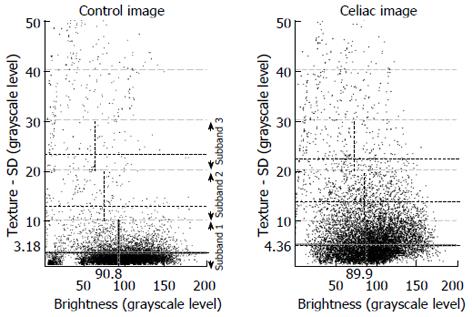Copyright
©2013 Baishideng Publishing Group Co.
World J Gastrointest Endosc. Jul 16, 2013; 5(7): 313-322
Published online Jul 16, 2013. doi: 10.4253/wjge.v5.i7.313
Published online Jul 16, 2013. doi: 10.4253/wjge.v5.i7.313
Figure 1 Color images from videocapsule device.
Differences in celiac images where villous atrophy is present are shown vs control. Control images have a more uniform texture at the mucosal surfaces. Celiac surfaces have a rougher appearance, with more fissuring, large protrusions, and scalloping along the folds.
Figure 2 The method of using subbands in the standard deviation of image texture.
Subbands are shown to the right of the control scatterplot. Mean values for each of the two variables are noted as hatched lines in each subband. The subband characteristics differ in celiac vs control videoclip series. In the control scatterplot the points are concentrated at low values of standard deviation in texture. In the celiac scatterplot the points are concentrated at higher values of standard deviation in texture. Thus the celiac image data has a greater variability of pixel gray level, which can be used to distinguish it from the control image data.
Figure 3 Image transformation from two to three dimensions.
Coordinate axes are shown for reference. Examples of corresponding landmark locations are noted by asterisks. The gray levels of the two-dimensional endoscopic image at left are converted to a depth along the z axis in the three-dimensional projection at right. The characteristics of the surface protrusions in the three-dimensional image are used for distinguishing celiac from control patient data.
Figure 4 Examples of basis images derived from celiac vs control videoclip series.
A: Control; B: Celiacs. The celiac basis has more heterogeneous structure. There are dark lines running through the celiac basis images as well as black and white blotches. In contrast, the control basis images are mostly uniform, with only diffuse features being evident.
Figure 5 Examples of frequency spectra for celiac vs control.
The dominant period (DP) is the highest peak in the physiologic range, taken as 1-20 s per oscillation. The graphs are shown for locations 3 and 4 in the small intestine. In the control patient the DP is 6 and 5 s for location 3 and 4, respectively. In the celiac patient the DP is 9 and 10 s for location 3 and 4, respectively. Thus the DP is higher for the celiac patient.
- Citation: Ciaccio EJ, Tennyson CA, Bhagat G, Lewis SK, Green PH. Implementation of a polling protocol for predicting celiac disease in videocapsule analysis. World J Gastrointest Endosc 2013; 5(7): 313-322
- URL: https://www.wjgnet.com/1948-5190/full/v5/i7/313.htm
- DOI: https://dx.doi.org/10.4253/wjge.v5.i7.313













